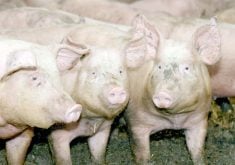The North American horse industry is moving slowly toward individual identification.
This highly mobile industry is still working on the specifics, but most agree identification is needed not only for theft deterrence but to track animals for food safety and disease purposes.
Canada exports about 100,000 tonnes of horse meat to Europe each year so traceback is necessary to deal with concerns over antibiotic or other drug use, said Vel Evans, project co-ordinator for the equine Canada identification program.
Identification using unique individual numbers and physical descriptions can be used for horse health, food safety and to simplify the current documentation required to move horses.
Read Also

The Western Producer Livestock Report – October 2, 2025
Western Producer Livestock Report for October 2, 2025. See U.S. & Canadian hog prices, Canadian bison & lamb market data and sale insight.
“Most likely there will be a double ID for horses in Canada,” said Evans at the Animal Transportation Association meeting held in Calgary.
Standardized documents for transport, change of ownership or veterinary care are also necessary.
Those who wish to use approved microchips need to insert them in a standard position on the neck in the nuchal ligament, and the device number must be recorded in a central database.
The voluntary program will be phased in starting with sectors that already have identification in one of Canada’s 26 pedigree associations or sports and competition registries. The next step moves out to the general population of unregistered horses and will rely on data from horse sales and transport documents.
The first phase of the program starts this year with the creation of an identification agency accepting foals registered in 2006.
In 2007, the second phase involves tracking movement among premises or where horse activities occur. Under the third phase recording mechanisms will be used.
In the United States, horse identification is tied to the national livestock identification program, said Amy Mann of the American Horse Council.
An equine working group started in 2004 as a program for disease control rather than to identify all the horses in the U.S. There are seven to nine million horses in the U.S. and some move two to four times per week.
“Trying to track those movements presents us with a tremendous challenge,” she said.
The plan is to preserve existing identification programs like brands, tattoos, microchips and DNA. Each is adequate for the purpose it was designed for, but may be inadequate for a national program. A voluntary program using approved microchips is most likely.
American horses will also receive a lifetime number of 15 digits including the country code and breed codes. The U.S. needs 32 million numbers for its registry.

















